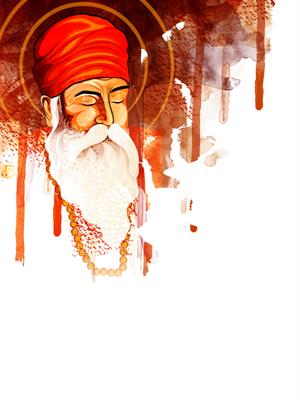BAGHEL SINGH (d. 1802), who succeeded in 1765 Karora Singh as leader of the Karor singhia misi or chief ship, is celebrated in Sikh history as the vanquisher of Mughal Delhi. A Dhalival Jatt, Baghel Singh arose from the village of Jhabal, in Amritsar district, to become a formidable force in the cis Sutlej region. According to Syad Muhammad Latif, he had under him 12,000 fighting men. As well as being a soldier, he was an adept in political negotiation and was able to win over many an adversary to his side. The Mughals, the Ruhilas, the Marathas and the English sought his friendship.
BENI, BHAGAT is one of the fifteen saints and sufis some of whose compositions have been incorporated in the Guru Granth Sahib. Very little is known about his personal life except that he spent most of his time in prayer and contemplation. Nabhaji`s Bhagatmal, which includes him in its roster of well known bhaktas or devotees, narrates a popular anecdote about how Beni absorbed in meditation often neglected the household needs and how the Deity himself intervened and physically appeared to help him. Bhai Gurdas (Varan, X. 14) has referred to Bern`s single pointed meditation in solitude enriched by moments of spiritual edification. Bern`s three hymns in the Guru Granth Sahib are marked by an intense spiritual longing.
BHAGBHARI, MAI (d. 1614), of a Brahman family of Srinagar, was converted to the Sikh faith by Bhai Madho Sodhi, sent by Guru Arjan to preach in Kashmir. As she grew old, she wished to have a glimpse of the Guru before she died. Guru Hargobind then occupied the spiritual throne of Guru Nanak. Mai Bhagbhari had stitched a role of homespun fabric which she longed to present to the Guru personally, but she was too old to travel to distant Amritsar. As says Gurbilas Chhevin Patshahi, Guru Hargobind did visit Kashmir and, reaching Srinagar, he went straight to Mai Bhagbhari`s house in Hathi Gate area.

BHAKTI AND SIKHISM. The word bhakti is derived from Skt. bhaj, meaning to serve, honour, revere, love and adore. In the religious idiom, it is attachment or fervent devotion to God and is defined as "that particular affection which is generated by the knowledge of the attributes of the Adorable One." The concept is traceable to the Vedas where its intimations are audible in the hymns addressed to deities such as Varuna, Savitra and Usha.
BHANGA SINGH (d. 1815), a prominent sardar of the Karorsinghia chief ship, seized in January 1764, after the fall of Sirhind, the parganah of Pehova along the bed of the River Sarasvati, 22 km west of Thanesar. Later he captured Thanesar leaving Pehova in the possession of his brother, Bhag Singh. Bhanga Singh and Bhag Singh commanded a force of 750 horse and 250 foot. In 1779, Bhanga Singh aligned himself with the Mughal chief, Abdul Ahd Khan, to recover his territory from Raja Amar Singh of Patiala. In January 1786, Bhanga Singh along with other Sikh chiefs entered the Ganga Doab at the head of 5,000 horse and ravaged Meerut, Hapur and Garh Mukteshvar. In April 1789, Mahadji Scindia, regent of the Mughal empire, confirmed Bhanga Singh`s right to rakhi or cess levied for protection in some of the areas under his influence.






